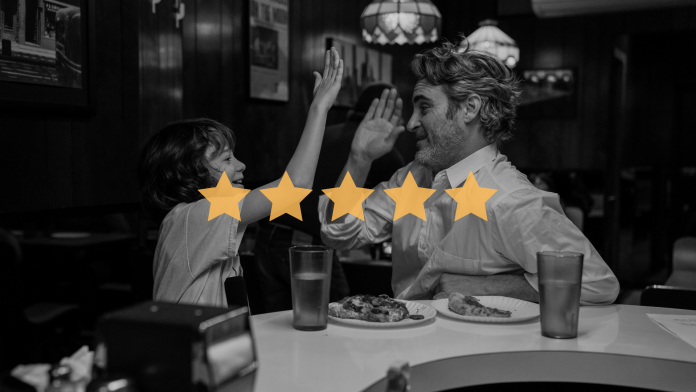Director Mike Mills is back with another beautifully crafted, family-centred story. As tender as it is wounding, C’mon C’mon brings black-and-white cityscapes in line with moving conversations and relational love, looking to the future while mining the past.
★★★★★
C’mon C’mon is a dream-like, drifting and unapologetically humanist film. An invitation into familial restoration—past, present and future—it is a film in which memories, painful and proud, are at the foreground of everything that takes place. Whereas director Mike Mills’ previous films, Beginners and 20th Century Women, centred on relationships with his father and mother, C’mon C’mon is an ode from the director to his child. A stunning meditation on all the things that come into your life when you try to look after another little person, the film is about the burden of responsibility but also the beauty of it.
For a film that blends its tenses, Mills describes C’mon C’mon unashamedly as a “post-2016 film”—a work of art rooted concretely in time. The spectre of Trump loomed over the creation of the film and is a ghost that continues to haunt this generation’s perceptions of society. The minimal plot follows Johnny (Joaquin Phoenix), a radio journalist, whose job it is to interview young people across Los Angeles, Oakland, New York, Detroit and New Orleans. He asks them one question in particular, “When you think of the future, what do you imagine it’ll be?”. When his torn sister, Viv (Gaby Hoffmann), explains that she must look after her partner Paul (Scoot McNairy), who desperately needs care, Johnny offers to support his nephew Jesse (Woody Norman). Johnny, the oft question master, is forced to reason with his own lack of answers and his refusal to take responsibility for his countless actions and inactions, past and present.
At the heart of each of Mills’ films is an invitation disguised as a whisper. He uses frames within frames, moving in through doorways, mirrors and windows, as we enter and observe wrestling, relationships and movements of the mind. Mills is consciously influenced by the great humanist filmmakers, champions of a people-centred approach, and the film retains the playfulness of Yasijuro Ozu’s Good Morning and the surgical precision of Jørgen Leth’s The Perfect Human. What is most impressive is how C’mon C’mon moves between modes of expression—a collage of documentary, narrative, art house and convention—the product of a conversation, a divine dance, between different components of filmmaking. It doesn’t take sides.
Mills is a genius when it comes to sketching subtle, sentimental moments. Contrary to the way Aaron Sorkin is lauded for his escalating, symphonic use of dialogue, Mills ransacks you with silent truths, using out of sync, even slurring, sounds and words that bleed beautifully from scene to scene. This technique, married with the restrained black-and-white cinematography, creates soft city dreamscapes brimmed with potential. The film is disorienting enough to force you to focus, without being so disorienting that the disorientation itself becomes the focus. It is a drawing, not a portrait, designed to be quick, ephemeral and unfolding.
C’mon C’mon reminds us of the cost of moments we can’t even remember, and the imperfections of those we do.
Much has been written, and deservedly so, about the main relationship between Johnny and Jesse. Joaquin Phoenix further cements himself as one of the greatest and most versatile actors of his generation and Woody Norman brings so much more than precociousness to his role. But the film hinges on the character of Viv. What Gaby Hoffmann achieves in relatively minimal screen time, the majority of which is conducted over the phone, is astounding. Quite simply, the film does not work if we don’t believe her rationale, empathise with her pain, feel the tears of her heart and see the tears on her cheeks. Most of Johnny and Viv’s scenes together were shot right up front, helping to cultivate a very real relationship between the actors, and their separation feels palpable. When Johnny is blindsided by a conversation about Viv’s past, his incoherent stumbling only exemplifies the distance between them and the scale of the healing to come.
Mills said, when filming C’mon C’mon, that he “wanted to be a visitor, not a tourist”. In doing so, he has created the kindest, least antagonistic film of 2021. He makes use of a respectful and unimposing camera. There is freedom in which each young person is treated as sacred, as deserving of a film in and of themselves. The use of intertextuality, quite literally referencing other works of literature on screen, has wrongfully been labelled as pretentious. In fact, it is another example of Mills’ egoless approach to his craft. His collaborative and decentring philosophy is rooted in his belief in the fragmentary and meagre nature of memories. They are slippery and changing; the more you look at them the more you can’t see them. C’mon C’mon reminds us of the cost of moments we can’t even remember, and the imperfections of those we do.
The Verdict
C’mon C’mon is an accomplishment of empathy, patient and powerful in equal measure. The painful and complicated portrayal of family relations intertwines sublimely with real-life documentary footage to lovingly enrapture the viewer in a collage of dreams, fears and memories.
Words by Ben Thomas
Support The Indiependent
We’re trying to raise £200 a month to help cover our operational costs. This includes our ‘Writer of the Month’ awards, where we recognise the amazing work produced by our contributor team. If you’ve enjoyed reading our site, we’d really appreciate it if you could donate to The Indiependent. Whether you can give £1 or £10, you’d be making a huge difference to our small team.
